Wei-Chih Hung
EMMA: End-to-End Multimodal Model for Autonomous Driving
Oct 30, 2024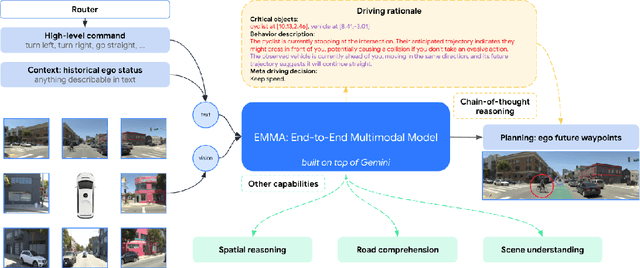

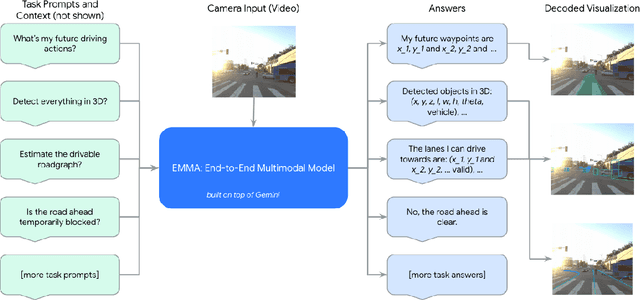

Abstract:We introduce EMMA, an End-to-end Multimodal Model for Autonomous driving. Built on a multi-modal large language model foundation, EMMA directly maps raw camera sensor data into various driving-specific outputs, including planner trajectories, perception objects, and road graph elements. EMMA maximizes the utility of world knowledge from the pre-trained large language models, by representing all non-sensor inputs (e.g. navigation instructions and ego vehicle status) and outputs (e.g. trajectories and 3D locations) as natural language text. This approach allows EMMA to jointly process various driving tasks in a unified language space, and generate the outputs for each task using task-specific prompts. Empirically, we demonstrate EMMA's effectiveness by achieving state-of-the-art performance in motion planning on nuScenes as well as competitive results on the Waymo Open Motion Dataset (WOMD). EMMA also yields competitive results for camera-primary 3D object detection on the Waymo Open Dataset (WOD). We show that co-training EMMA with planner trajectories, object detection, and road graph tasks yields improvements across all three domains, highlighting EMMA's potential as a generalist model for autonomous driving applications. However, EMMA also exhibits certain limitations: it can process only a small amount of image frames, does not incorporate accurate 3D sensing modalities like LiDAR or radar and is computationally expensive. We hope that our results will inspire further research to mitigate these issues and to further evolve the state of the art in autonomous driving model architectures.
STT: Stateful Tracking with Transformers for Autonomous Driving
Apr 30, 2024Abstract:Tracking objects in three-dimensional space is critical for autonomous driving. To ensure safety while driving, the tracker must be able to reliably track objects across frames and accurately estimate their states such as velocity and acceleration in the present. Existing works frequently focus on the association task while either neglecting the model performance on state estimation or deploying complex heuristics to predict the states. In this paper, we propose STT, a Stateful Tracking model built with Transformers, that can consistently track objects in the scenes while also predicting their states accurately. STT consumes rich appearance, geometry, and motion signals through long term history of detections and is jointly optimized for both data association and state estimation tasks. Since the standard tracking metrics like MOTA and MOTP do not capture the combined performance of the two tasks in the wider spectrum of object states, we extend them with new metrics called S-MOTA and MOTPS that address this limitation. STT achieves competitive real-time performance on the Waymo Open Dataset.
3D Open-Vocabulary Panoptic Segmentation with 2D-3D Vision-Language Distillation
Jan 04, 2024



Abstract:3D panoptic segmentation is a challenging perception task, which aims to predict both semantic and instance annotations for 3D points in a scene. Although prior 3D panoptic segmentation approaches have achieved great performance on closed-set benchmarks, generalizing to novel categories remains an open problem. For unseen object categories, 2D open-vocabulary segmentation has achieved promising results that solely rely on frozen CLIP backbones and ensembling multiple classification outputs. However, we find that simply extending these 2D models to 3D does not achieve good performance due to poor per-mask classification quality on novel categories. In this paper, we propose the first method to tackle 3D open-vocabulary panoptic segmentation. Our model takes advantage of the fusion between learnable LiDAR features and dense frozen vision CLIP features, using a single classification head to make predictions for both base and novel classes. To further improve the classification performance on novel classes and leverage the CLIP model, we propose two novel loss functions: object-level distillation loss and voxel-level distillation loss. Our experiments on the nuScenes and SemanticKITTI datasets show that our method outperforms strong baselines by a large margin.
ARTIC3D: Learning Robust Articulated 3D Shapes from Noisy Web Image Collections
Jun 07, 2023



Abstract:Estimating 3D articulated shapes like animal bodies from monocular images is inherently challenging due to the ambiguities of camera viewpoint, pose, texture, lighting, etc. We propose ARTIC3D, a self-supervised framework to reconstruct per-instance 3D shapes from a sparse image collection in-the-wild. Specifically, ARTIC3D is built upon a skeleton-based surface representation and is further guided by 2D diffusion priors from Stable Diffusion. First, we enhance the input images with occlusions/truncation via 2D diffusion to obtain cleaner mask estimates and semantic features. Second, we perform diffusion-guided 3D optimization to estimate shape and texture that are of high-fidelity and faithful to input images. We also propose a novel technique to calculate more stable image-level gradients via diffusion models compared to existing alternatives. Finally, we produce realistic animations by fine-tuning the rendered shape and texture under rigid part transformations. Extensive evaluations on multiple existing datasets as well as newly introduced noisy web image collections with occlusions and truncation demonstrate that ARTIC3D outputs are more robust to noisy images, higher quality in terms of shape and texture details, and more realistic when animated. Project page: https://chhankyao.github.io/artic3d/
Hi-LASSIE: High-Fidelity Articulated Shape and Skeleton Discovery from Sparse Image Ensemble
Dec 28, 2022Abstract:Automatically estimating 3D skeleton, shape, camera viewpoints, and part articulation from sparse in-the-wild image ensembles is a severely under-constrained and challenging problem. Most prior methods rely on large-scale image datasets, dense temporal correspondence, or human annotations like camera pose, 2D keypoints, and shape templates. We propose Hi-LASSIE, which performs 3D articulated reconstruction from only 20-30 online images in the wild without any user-defined shape or skeleton templates. We follow the recent work of LASSIE that tackles a similar problem setting and make two significant advances. First, instead of relying on a manually annotated 3D skeleton, we automatically estimate a class-specific skeleton from the selected reference image. Second, we improve the shape reconstructions with novel instance-specific optimization strategies that allow reconstructions to faithful fit on each instance while preserving the class-specific priors learned across all images. Experiments on in-the-wild image ensembles show that Hi-LASSIE obtains higher fidelity state-of-the-art 3D reconstructions despite requiring minimum user input.
Optimizing Anchor-based Detectors for Autonomous Driving Scenes
Aug 11, 2022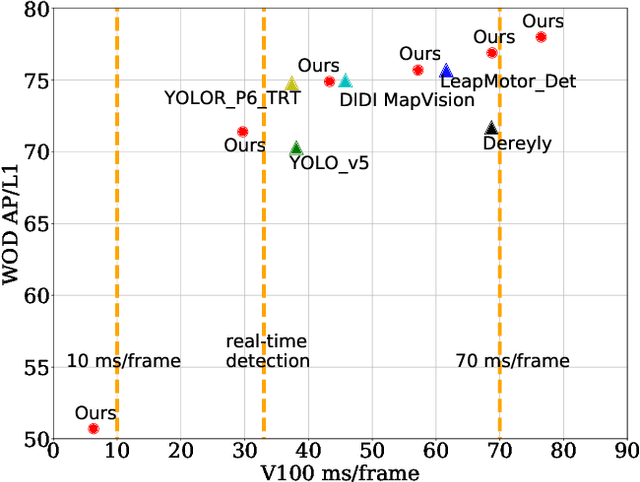
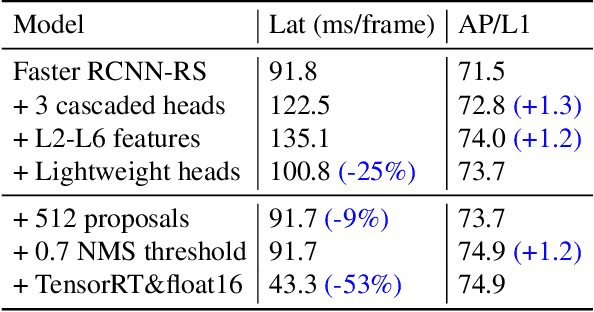
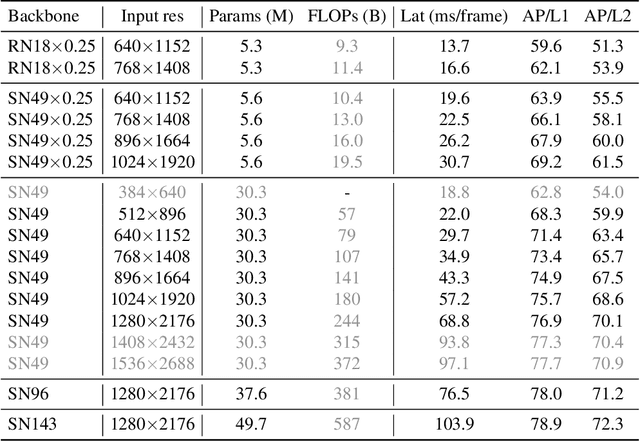
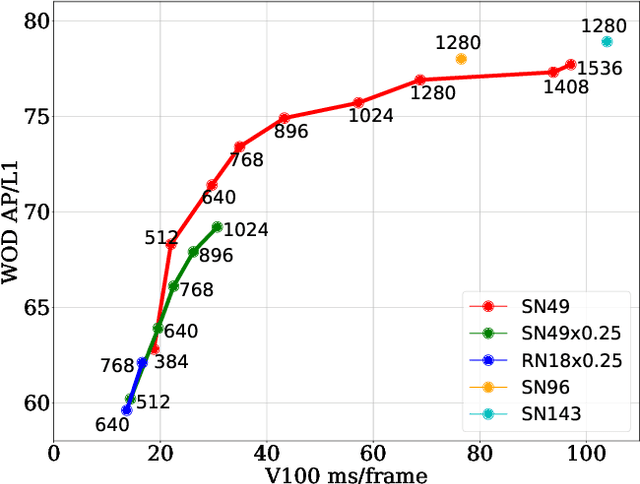
Abstract:This paper summarizes model improvements and inference-time optimizations for the popular anchor-based detectors in the scenes of autonomous driving. Based on the high-performing RCNN-RS and RetinaNet-RS detection frameworks designed for common detection scenes, we study a set of framework improvements to adapt the detectors to better detect small objects in crowd scenes. Then, we propose a model scaling strategy by scaling input resolution and model size to achieve a better speed-accuracy trade-off curve. We evaluate our family of models on the real-time 2D detection track of the Waymo Open Dataset (WOD). Within the 70 ms/frame latency constraint on a V100 GPU, our largest Cascade RCNN-RS model achieves 76.9% AP/L1 and 70.1% AP/L2, attaining the new state-of-the-art on WOD real-time 2D detection. Our fastest RetinaNet-RS model achieves 6.3 ms/frame while maintaining a reasonable detection precision at 50.7% AP/L1 and 42.9% AP/L2.
LASSIE: Learning Articulated Shapes from Sparse Image Ensemble via 3D Part Discovery
Jul 07, 2022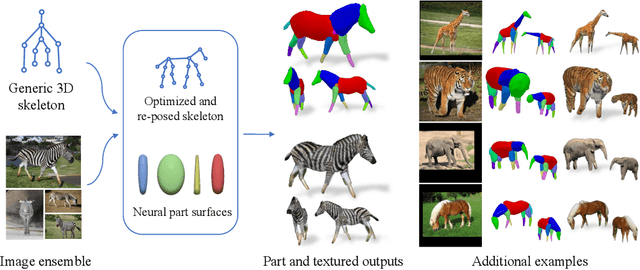

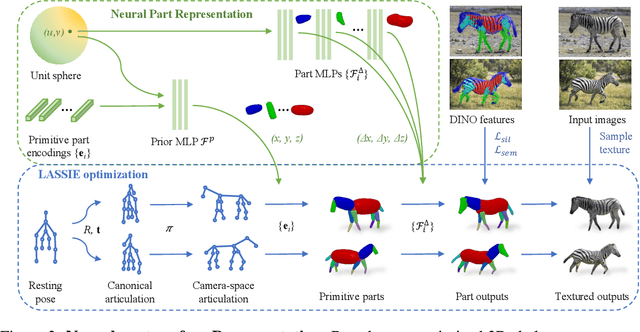

Abstract:Creating high-quality articulated 3D models of animals is challenging either via manual creation or using 3D scanning tools. Therefore, techniques to reconstruct articulated 3D objects from 2D images are crucial and highly useful. In this work, we propose a practical problem setting to estimate 3D pose and shape of animals given only a few (10-30) in-the-wild images of a particular animal species (say, horse). Contrary to existing works that rely on pre-defined template shapes, we do not assume any form of 2D or 3D ground-truth annotations, nor do we leverage any multi-view or temporal information. Moreover, each input image ensemble can contain animal instances with varying poses, backgrounds, illuminations, and textures. Our key insight is that 3D parts have much simpler shape compared to the overall animal and that they are robust w.r.t. animal pose articulations. Following these insights, we propose LASSIE, a novel optimization framework which discovers 3D parts in a self-supervised manner with minimal user intervention. A key driving force behind LASSIE is the enforcing of 2D-3D part consistency using self-supervisory deep features. Experiments on Pascal-Part and self-collected in-the-wild animal datasets demonstrate considerably better 3D reconstructions as well as both 2D and 3D part discovery compared to prior arts. Project page: chhankyao.github.io/lassie/
LET-3D-AP: Longitudinal Error Tolerant 3D Average Precision for Camera-Only 3D Detection
Jun 15, 2022



Abstract:The popular object detection metric 3D Average Precision (3D AP) relies on the intersection over union between predicted bounding boxes and ground truth bounding boxes. However, depth estimation based on cameras has limited accuracy, which may cause otherwise reasonable predictions that suffer from such longitudinal localization errors to be treated as false positives and false negatives. We therefore propose variants of the popular 3D AP metric that are designed to be more permissive with respect to depth estimation errors. Specifically, our novel longitudinal error tolerant metrics, LET-3D-AP and LET-3D-APL, allow longitudinal localization errors of the predicted bounding boxes up to a given tolerance. The proposed metrics have been used in the Waymo Open Dataset 3D Camera-Only Detection Challenge. We believe that they will facilitate advances in the field of camera-only 3D detection by providing more informative performance signals.
Semi-supervised Multi-task Learning for Semantics and Depth
Oct 14, 2021
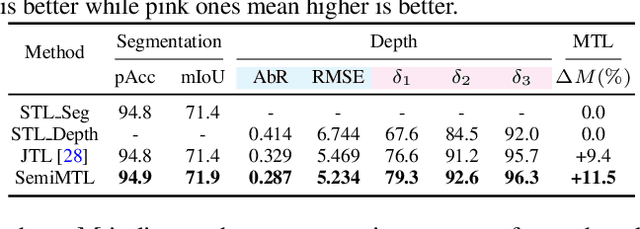

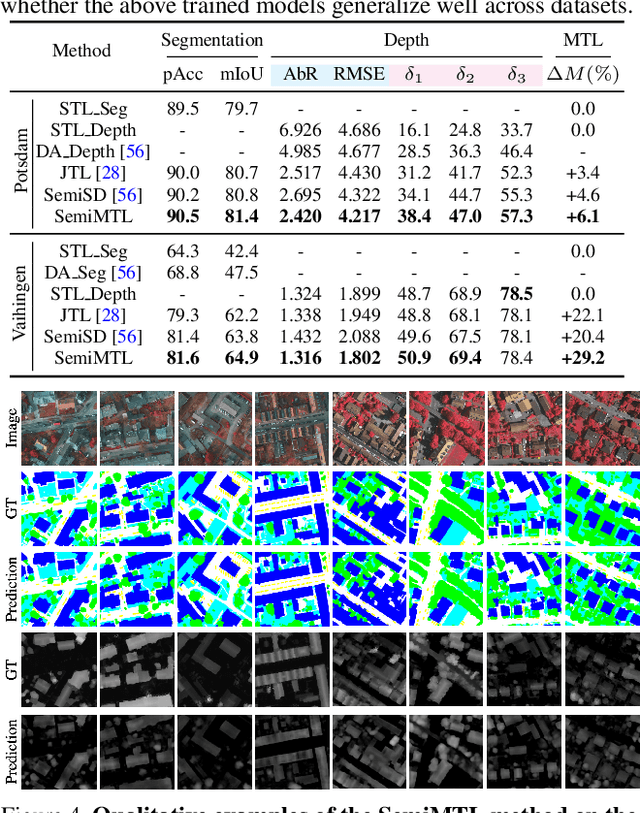
Abstract:Multi-Task Learning (MTL) aims to enhance the model generalization by sharing representations between related tasks for better performance. Typical MTL methods are jointly trained with the complete multitude of ground-truths for all tasks simultaneously. However, one single dataset may not contain the annotations for each task of interest. To address this issue, we propose the Semi-supervised Multi-Task Learning (SemiMTL) method to leverage the available supervisory signals from different datasets, particularly for semantic segmentation and depth estimation tasks. To this end, we design an adversarial learning scheme in our semi-supervised training by leveraging unlabeled data to optimize all the task branches simultaneously and accomplish all tasks across datasets with partial annotations. We further present a domain-aware discriminator structure with various alignment formulations to mitigate the domain discrepancy issue among datasets. Finally, we demonstrate the effectiveness of the proposed method to learn across different datasets on challenging street view and remote sensing benchmarks.
Discovering 3D Parts from Image Collections
Jul 28, 2021

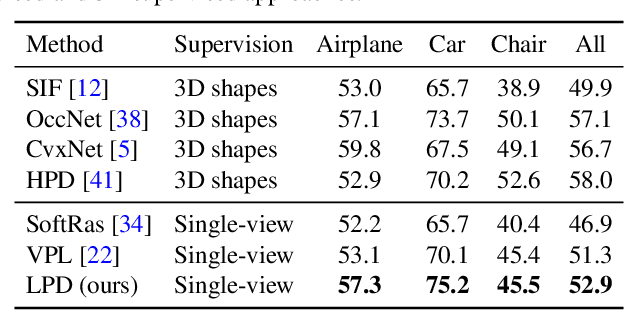

Abstract:Reasoning 3D shapes from 2D images is an essential yet challenging task, especially when only single-view images are at our disposal. While an object can have a complicated shape, individual parts are usually close to geometric primitives and thus are easier to model. Furthermore, parts provide a mid-level representation that is robust to appearance variations across objects in a particular category. In this work, we tackle the problem of 3D part discovery from only 2D image collections. Instead of relying on manually annotated parts for supervision, we propose a self-supervised approach, latent part discovery (LPD). Our key insight is to learn a novel part shape prior that allows each part to fit an object shape faithfully while constrained to have simple geometry. Extensive experiments on the synthetic ShapeNet, PartNet, and real-world Pascal 3D+ datasets show that our method discovers consistent object parts and achieves favorable reconstruction accuracy compared to the existing methods with the same level of supervision.
 Add to Chrome
Add to Chrome Add to Firefox
Add to Firefox Add to Edge
Add to Edge